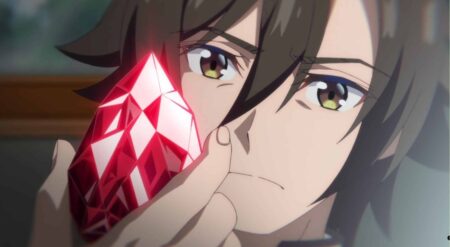
Based on the Shōjo manga written and illustrated by Mashiro, Loving Yamada at Lv999! Season 1 is a charming and spirited romance with a charismatic lead anchoring the story. While there’s no boundary pushing in the adaptation, directed and often storyboarded by Morio Asaka, the series offers a level of comfort in familiarity while delivering on tropes with expertise. A good trope is favored for a reason, and the series manages to deliver specific romance elements that play to the classic structure of the genre while maintaining a level of fresh characterization so as to not simply add to the fodder.
College student Akane Kinoshita (Inori Minase) has been recently dumped by her boyfriend but can’t seem to quit the MMORPG Forest of Savior game they played together. While attending an offline event for the game, she meets a third-year highschool student, Akito Yamada (Koki Uchiyama), her exact opposite. She’s lively and prone to emotional outbursts, while he’s reserved with his emotions, appearing cold to many on the first encounter. The series follows both their burgeoning relationship as well as her developing friendships with the others in her guild.
A romance anime means nothing if the central relationship fails to engage with the audience. We need to root for them in some capacity, even if in the end we end up enjoying supporting characters more than the main couple. Akane and Akito are terrific characters from the start, especially in how they contrast their personalities to their appearance and even the way they’re animated. Akane is an endlessly charming character in particular whose stumbling is often counterbalanced by her innate kindness she shows both to Akito — such as when she races to her home to bring him packed food after learning he lives alone — to forgiveness towards middle school gremlin Runa (Ai Kakuma.)
It’s the latter’s introduction to the series and her friendship with Akane that helps revitalize the series after an opening few episodes that meander in the plot. Runa’s characterization in general is one of the series highlights, as the show allows her to grow while also refusing to strip her of some of her more comedic elements. She’s possessive of her guild and is furious at first at the idea of Akane stepping in, so used to basking in the guild’s attention as the youngest. She grows to form a strong friendship with Akane but maintains that wariness of others, growing incensed again later in the series when it’s suggested that another new member may join.

The animation clearly has fun with the dynamic between Akane and Runa, with character designs and details that flesh out their age differences while highlighting an innate, sibling energy between the two of them. From Akane’s lack of self-consciousness in trying to get Runa to dance in public to Runa’s obvious distaste at Akane getting drunk, some of the lighter and most comedic moments are due to scenes they share.
Aside from that, Akito and Akane are given the bulk amount of growth. Their relationship is an ultimate slow burn, though they show their care for one another throughout the entire series. The biggest installment in terms of development occurs in Episode 10 when Akane falls ill and Akito takes charge of looking after her as she recovers. “I’ll Definitely Be Hurt Someday” is a standout on all fronts, especially as get to see the version of Akito that all of his friends know to be his true self as he cares for Akane selflessly. Directed by Mitsutaka Noshitani and Cheng Xiang Tai, the episode also allows for loose animation styles, with the sick version of Akane drawn in straight lines and wide, chibi-style art, to reflect the fatigue she’s feeling from being sick.
The animation in general varies greatly from beautiful character design that leans heavily into facial distinction — especially in the first and final episode — to stagnant. The series thrives on small bursts of character action, be it Runa’s eagerness of being at a fancy restaurant, Akane being inebriated, or her flying through her room to hide her bras drying in the window. It wilts, however, in moments that rely too much on shared or longing looks, especially as they stretch the amount of time necessary for them to leave any sort of impact, verging on parody due to the length. Stillness in anime isn’t new or inherently bad, but it needs to either be justified, visually engaging despite the lack of movement, or driven by voice-over dialogue.
Regardless, charm is abundant in Loving Yamada at Lv999! Season 1. Ending on a note that offers closure while opening the door for (hopefully) a second season to further explore the central couple’s romance, the series delivers a lovely, simplistic romance that understands its genre and leans into it. The allure stems from the comfort the series brings, while the character’s magnetism and the central relationship are what keep viewers coming back.
Loving Yamada at Lv999! Season 1 isout now on Crunchyroll.
Loving Yamada at Lv999! Season 1
-
Rating - 7/107/10
TL;DR
Charm is abundant in Loving Yamada at Lv999! Season 1. Ending on a note that offers closure while opening the door for (hopefully) a second season to further explore the central couple’s romance, the series delivers a lovely, simplistic romance that understands its genre and leans into it.






